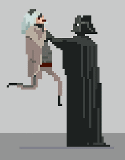This is going to be kind of a rant, but not really. I have questions, so any programmer feel free to speak up!
With the advances in technology, games are getting more and more complex, and require faster processors to run. Along those same lines, the tools are harder to use. Nowadays you need software worth thousands of dollars just to make a game character, and the levels.. level editing aint what it used to be.
I used to edit Doom2 and then later on, Duke nukem 3d. If you've ever used the duke3d level editor, you probably know where this is going. What you did was draw your sector in the map view, and add verts as you see fit, then with a press of a key you are in an in-game like environment, where you can raise and lower the ceiling or floor, apply a slope, add decals etc. Everything you would normally do in the orthographic views of say, gtk radiant, you would do in the full screen 3d view. it was intuitive and EASY. Brush editing just isnt as fast and easy (or more powerful. the only limits were on the game engine itself)
Games today use shadow maps. Looks pretty, but dynamic lighting is pretty much out the window. To me, it seems almost like a step back.(not graphically, but tech wise) Doom3's lighting is insanely processor intensive. My idea? use some sort of lod system that subdivides surfaces based on distance to the player. You know, keep the already fast vertex lighting up to date.
How come no game engines use vector based images for.. well, anything? You could use them for text, or particles, or even textures. I know for a fact they render faster than bitmaps (depending on complexity of course), and you get the added bonus of infinite scaling with no jaggies.
Ah, if only I was a programmer
With the advances in technology, games are getting more and more complex, and require faster processors to run. Along those same lines, the tools are harder to use. Nowadays you need software worth thousands of dollars just to make a game character, and the levels.. level editing aint what it used to be.
I used to edit Doom2 and then later on, Duke nukem 3d. If you've ever used the duke3d level editor, you probably know where this is going. What you did was draw your sector in the map view, and add verts as you see fit, then with a press of a key you are in an in-game like environment, where you can raise and lower the ceiling or floor, apply a slope, add decals etc. Everything you would normally do in the orthographic views of say, gtk radiant, you would do in the full screen 3d view. it was intuitive and EASY. Brush editing just isnt as fast and easy (or more powerful. the only limits were on the game engine itself)
Games today use shadow maps. Looks pretty, but dynamic lighting is pretty much out the window. To me, it seems almost like a step back.(not graphically, but tech wise) Doom3's lighting is insanely processor intensive. My idea? use some sort of lod system that subdivides surfaces based on distance to the player. You know, keep the already fast vertex lighting up to date.
How come no game engines use vector based images for.. well, anything? You could use them for text, or particles, or even textures. I know for a fact they render faster than bitmaps (depending on complexity of course), and you get the added bonus of infinite scaling with no jaggies.
Ah, if only I was a programmer





